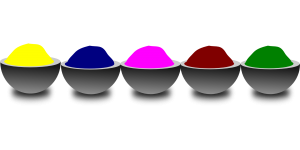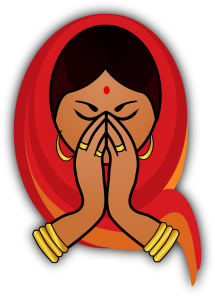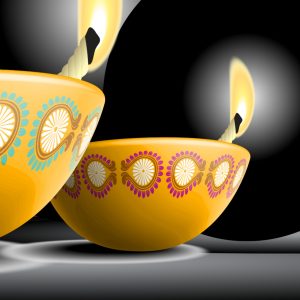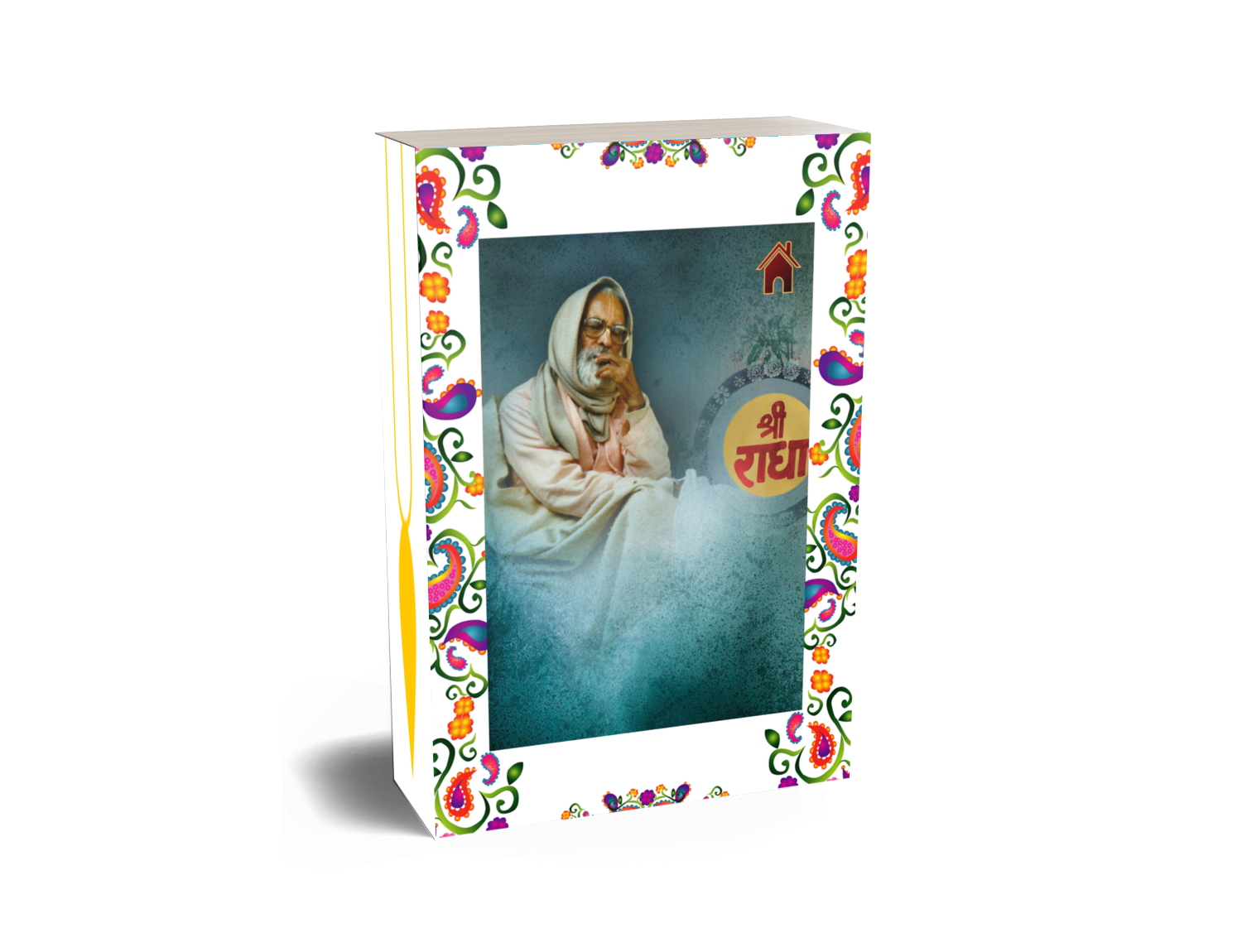

Excerpt from the book Ācārya Kesarī Śrī Śrīmad Bhakti Prajñāna Keśava Gosvāmī – His Life and Teachings, 2nd Edition by Śrīla Bhaktivedānta Nārāyaṇa Mahārāja
Śrī Śrī Rādhā-Vinoda-bihārījī are the presiding deities in Śrī Keśavajī Gauḍīya Maṭha. When They were installed, some Vaiṣṇavas were curious to know why both the deities have the same colour, and they respectfully asked Śrīla Ācārya Kesarī, “In our Gauḍīya sampradāya and elsewhere, Śrīmatī Rādhikā’s deity is made of white marble and Śrī Kṛṣṇa’s is made of black marble. How is it that both the deities you have manifested are white?” Śrīla Ācāryadeva answered this question in a beautiful and unprecedented way by composing Śrī Śrī Rādhā-Vinoda-bihārī tattvāṣṭakam. Paramārādhya Śrīla Gurudeva has wonderfully manifested the fathomless ocean of śrī rādhā-tattva, śrī kṛṣṇa-tattva, prema-tattva, rasa-tattva and the topmost rūpānuga current of thought within the small pot of this tattvāṣṭakam. We will try to reveal something of his sentiments in the following explanation, using śākhā-candranyāya, the logic of the branch and the moon.*
rādhā-cintā-niveśena
yasya kāntir vilopitā
śrī-kṛṣṇa-caraṇaṁ vande
rādhāliṅgita-vigraham (1)
We pray at the lotus feet of that form of Śrī Kṛṣṇa, who is embraced and marked by Śrī Rādhikā (rādhāliṅgita and rādhācihnita). When Śrīmatī Rādhikā, the personification of mahābhāva, displayed māna, Her jealous anger, Śrī Kṛṣṇa became thoroughly immersed in separation from Her. His own dark complexion vanished and He assumed Her bright, golden lustre. Or, we pray at the lotus feet of Śrī Kṛṣṇa who is beautified by Śrīmatī Rādhikā’s golden lustre when She embraces Him after Her māna has broken.
Tattva-prakāśikā-vṛtti – the commentary which illuminates the philosophical principles
In this verse the word rādhāliṅgita has two meanings. The first is rādhayā liṅgita – marked by Śrī Rādhā. The second meaning is rādhayā āliṅgita – embraced by Śrīmatī Rādhikā. When Śrīmatī Rādhikā exhibits māna, and dhīra-lalita nāyaka Śrī Kṛṣṇa becomes completely absorbed in feelings of separation from Her, His natural, bluish radiant lustre disappears and He helplessly accepts Śrīmatī Rādhikā’s golden complexion. In other words, His own lustre becomes golden. He does not have to perform even the slightest endeavour for this; it happens automatically. It is like the strong bhṛṅgī wasp forcefully arresting the weak telacaṭṭā insect and confining it in its cave. When the weak insect hears the strange sound made by the bhṛṅgī, it becomes afraid, and constantly 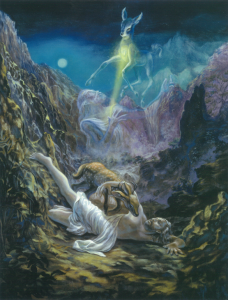 contemplating the form of the bhṛṅgī, it assumes a bodily form exactly like that of the bhṛṅgī.
contemplating the form of the bhṛṅgī, it assumes a bodily form exactly like that of the bhṛṅgī.
We can also give the example of Mahārāja Bharata, who was thinking of a fawn at the time of his death and so acquired the body of a deer in his next life. In the same way, Śrī Kṛṣṇa takes on Śrīmatī Rādhikā’s golden lustre as He becomes more and more absorbed in thoughts of Her.
One such incident is described in a conversation between Varāhadeva and Dharaṇī in the Varāha-saṁhitā. Śrī Varāhadeva told Dharaṇī, “In Vṛndāvana there is a large banyan tree on the bank of Yamunā, and its branches spread far and wide in all directions. Many different types of birds are always chirping on its branches. Surrounding the base of this tree is a beautiful raised platform on which Śrī Śrī Rādhā-Kṛṣṇa enjoy delightful pastimes. Once‚ Śrī Kṛṣṇa was relishing rāsa-līlā with His sakhīs on the bank of the Yamunā. Crores of gopīs were revelling in pastimes with Him 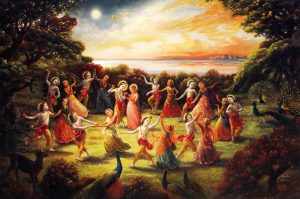 and He began to dance with the gopīs one after another, absorbed in ecstatic love, sometimes embracing one and sometimes another. Kṛṣṇa enjoyed a variety of loving exchanges, sometimes with Śrīmatī Rādhikā and sometimes with others.
and He began to dance with the gopīs one after another, absorbed in ecstatic love, sometimes embracing one and sometimes another. Kṛṣṇa enjoyed a variety of loving exchanges, sometimes with Śrīmatī Rādhikā and sometimes with others.
“Śrīmatī Rādhikā observed that Kṛṣṇa was embracing and dancing with other gopīs as He was with Her. Seeing that He was not honouring Her superiority over the other gopīs, She became angry with Him. She immediately left the rāsasthalī and hid in a nearby kuñja. After a short time, Kṛṣṇa noticed Śrīmatī Rādhikā’s absence and became restless. ‘She for whom I perform this rāsa-vilāsa, who is dearer to Me than My very life, has left Me,’ He thought. ‘Where did She go?’
“Dancing and dallying with millions and millions of gopīs could not capture Kṛṣṇa’s heart even for a moment.  Afflicted with separation from Śrīmatī Rādhikā, He left the rāsa-maṇḍalī at once and began to search in one kuñja after another, calling out, ‘O Rādhā, where are You?’ As He searched widely for Śrīmatī Rādhikā, the crown jewel of all His beloved sakhīs, He arrived at the bank of the Kālindī. By now He was tired and hopeless from His long search, so under the shade of a tamarind tree in a charming kuñja, He began chanting the name of Rādhā in deep anxiety. Sometimes He would call out in a melancholy way, ‘Praneśvarī! Alas! O Queen of My heart! You have deserted Me. Where have You gone?’
Afflicted with separation from Śrīmatī Rādhikā, He left the rāsa-maṇḍalī at once and began to search in one kuñja after another, calling out, ‘O Rādhā, where are You?’ As He searched widely for Śrīmatī Rādhikā, the crown jewel of all His beloved sakhīs, He arrived at the bank of the Kālindī. By now He was tired and hopeless from His long search, so under the shade of a tamarind tree in a charming kuñja, He began chanting the name of Rādhā in deep anxiety. Sometimes He would call out in a melancholy way, ‘Praneśvarī! Alas! O Queen of My heart! You have deserted Me. Where have You gone?’
rādhā viśleṣataḥ kṛṣṇaḥ
hy ekadā premā-vihvalaḥ
rādhā-mantraṁ japan dhyāyan
rādhā sarvatra paśyati
Varāha-saṁhitā
“Overwhelmed by deep separation from Śrīmatī Rādhikā, Śrī Kṛṣṇa madly chanted the rādhā-mantra. As He meditated on Her, She gradually began to manifest Herself to Him everywhere. Feeling Her presence inwardly and outwardly, He became like Śrīmatī Rādhikā, and His bodily lustre also became like Hers.” This is the first meaning of the word rādhāliṅgita.
Śrī Gaurasundara used to go to Imlitālā, because that is where this pastime took place and it is the location of that particular tamarind tree. Overwhelmed with emotion, He used to chant the holy name, weeping bitterly. In the afternoon, He would go to beg alms in a village near Akrūra ghāṭa. It seems that Śrī Gaurasundara came to Vraja-dhāma from Nīlācala only to attain and strengthen His rādhā-bhāva, because without rādhā-bhāva He would never fulfil His three desires.
Śrīla Rūpa Gosvāmī, the crest jewel of the dynasty of rasika Vaiṣṇavas, wrote the verse hariḥ puraṭa-sundara-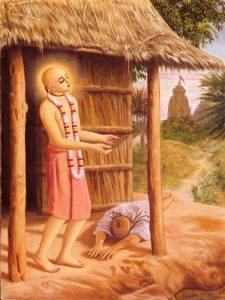 dyuti-kadamba-sandīpitaḥ. Here he indicates the form of Hari which is effulgent with the radiance of gold, meaning the form of Śrī Kṛṣṇa which is radiant with Rādhā’s golden splendour when He is deeply absorbed in thoughts of Her. Śrī Svarūpa Dāmodara, who is an intimate associate of Śrī Gaurasundara and also the rasa-śāstra guru, has indicated the same mood in his kaḍacā (notebook), “rādhā-bhāvadyuti-suvalitaṁ naumi kṛṣṇa-svarūpam – I repeatedly bow down to that Kṛṣṇa who is resplendent with the lustre and intrinsic mood of Śrīmatī Rādhikā.”
dyuti-kadamba-sandīpitaḥ. Here he indicates the form of Hari which is effulgent with the radiance of gold, meaning the form of Śrī Kṛṣṇa which is radiant with Rādhā’s golden splendour when He is deeply absorbed in thoughts of Her. Śrī Svarūpa Dāmodara, who is an intimate associate of Śrī Gaurasundara and also the rasa-śāstra guru, has indicated the same mood in his kaḍacā (notebook), “rādhā-bhāvadyuti-suvalitaṁ naumi kṛṣṇa-svarūpam – I repeatedly bow down to that Kṛṣṇa who is resplendent with the lustre and intrinsic mood of Śrīmatī Rādhikā.”
Now we will discuss the second meaning of rādhāliṅgita. Here the poet offers prayers to Śrī Kṛṣṇa when He is embraced by His beloved Śrī Rādhikā, who has assumed the mood of a svādhīna-bhartṛkā-nāyikā, the heroine who happily controls her lover after her māna (jealous anger) has broken. Seeing Kṛṣṇa bewildered in separation from Her, Śrīmatī Rādhikā’s heart also became aggrieved. Her self-control and sulkiness immediately disappeared and She bound Śrī Kṛṣṇa in the ropes of Her embrace. Kṛṣṇa then became content and all His grief and sorrows dissolved. Śrī Rāya Rāmānanda refers to this in his dialogue with Śrī Caitanya Mahāprabhu in Śrī Caitanya-caritāmṛta (Madhya-līlā 8.194):
nā so ramaṇa, nā hāma ramaṇī
duṅhu-mana manobhava peṣala jāni’
e sakhi, se-saba prema-kāhinī
kānu-ṭhāme kahabi vichurala jāni’
In the madness of love in separation, Śrīmatī Rādhikā says: Our prema reached its ultimate limit in the mere blink of an eye. We have met each other in such a way that We have become one; I have even forgotten that I am the beloved and You are My lover. Now I am separated from You, and this loving exchange has become like a mere fairy tale. Is this how virtuous men act in their pursuit of love?
This poem discloses the ultimate stage of milana, or meeting, in which Śrī Kṛṣṇa is completely embraced by Rādhikā. Soon after this, Rāya Rāmānanda said to Śrī Gaurasundara (Madhya-līlā 8.268–271):
pahile dekhiluṅ tomāra sannyāsi-svarūpa
ebe tomā dekhi muñi śyāma-gopa-rūpa
tomāra sammukhe dekhi kāñcana-pañcālikā
tāṅra gaura-kāntye tomāra sarva aṅga ḍhākā
tāhāte prakaṭa dekhoṅ sa-vaṁśī vadana
nānā bhāve cañcala tāhe kamala-nayana
ei-mata tomā dekhi’ haya camatkāra
akapaṭe kaha, prabhu, kāraṇa ihāra
The deep and confidential purport of these four verses is that Kṛṣṇa’s radiant bluish lustre is covered by Śrīmatī Rādhikā’s golden radiance, because each limb of Śrī Kṛṣṇa’s body is embraced by each limb of Śrīmatī Rādhikā’s body. The body of Muralīdhārī Śrī Kṛṣṇa remains unchanged; only His lustre becomes golden. It is this very form of Śrī Kṛṣṇa that is embraced by Śrīmatī Rādhikā, which is worshipped in all the temples of our Śrī Gauḍīya Vedānta Samiti.
This profoundly philosophical prayer, which is replete with the most exalted sentiments, clearly indicates its author’s exclusive allegiance to Śrī Rūpa Gosvāmī’s conception. To imbibe this elusive mood of the damsels of Vraja in our hearts, we must first understand the principles of bhakti. There are three stages in the progression of bhakti: sādhana-bhakti, bhāva-bhakti and in perfection, prema-bhakti. Sādhana-bhakti matures into bhāva-bhakti, and finally it matures into prema.
Sādhana-bhakti, which is performed during the stage of practice, has two divisions: vaidhī and rāgānuga. When the practice of bhakti bears the fruit of prema, there is still a corresponding subtle difference between prema arising from vaidhī-sādhana-bhakti and prema arising from rāgānuga-sādhana-bhakti. Prema which has developed from the performance of vaidhī-bhakti is imbued with reverence for Śrī Bhagavān’s majesty and is known as vaikuṇṭhīya-prema. Prema which is obtained through the cultivation of rāgānuga-bhakti is completely free from even a scent of reverence and is known as immaculate, sweet vraja-prema, the most elevated stage, which is exhibited in the mood of the gopīs.
In order to comprehend rāgānuga-bhakti properly, it is essential that one first understands rāgātmika-bhāva. Rāga is the unquenchable loving thirst arising from intense absorption in the object of one’s affection, Śrī Kṛṣṇa. The deep and intense loving attachment that this rāga produces is called rāgātmika-prema.
The distinctive and unique prīti, or love, of the eternal inhabitants of Vraja – including the cows, deer, parrots and other animals and birds – is called rāgātmika-prīti. It is of two types: sambandha-rūpā and kāma-rūpā. The term kāma-rūpā refers only to the affection of Kṛṣṇa’s beloved sweethearts, and the longing which follows in the wake of this kāma-rūpā rati is called kāmānuga-bhakti. Kāma-rūpā rāgātmika-prema is also of two kinds: sambhoga-icchāmayī and tat-tad-bhāva-icchāmayī. The rati of nāyikās such as Śrīmatī Rādhikā, Candrāvalī and Śyāmalā, who desire to meet Kṛṣṇa for His pleasure is called sambhoga-icchāmayī. Tāsāṁ bhāva-mādhurya-kāmitā (Bhakti-rasāmṛtasindhu 1.2.298). In other words, sakhīs who have tat-tad-bhāva-icchātmikā rati do not desire to meet Kṛṣṇa independently, but are intent on relishing Śrīmatī Rādhikā’s sweet mood when She meets with Him.
other animals and birds – is called rāgātmika-prīti. It is of two types: sambandha-rūpā and kāma-rūpā. The term kāma-rūpā refers only to the affection of Kṛṣṇa’s beloved sweethearts, and the longing which follows in the wake of this kāma-rūpā rati is called kāmānuga-bhakti. Kāma-rūpā rāgātmika-prema is also of two kinds: sambhoga-icchāmayī and tat-tad-bhāva-icchāmayī. The rati of nāyikās such as Śrīmatī Rādhikā, Candrāvalī and Śyāmalā, who desire to meet Kṛṣṇa for His pleasure is called sambhoga-icchāmayī. Tāsāṁ bhāva-mādhurya-kāmitā (Bhakti-rasāmṛtasindhu 1.2.298). In other words, sakhīs who have tat-tad-bhāva-icchātmikā rati do not desire to meet Kṛṣṇa independently, but are intent on relishing Śrīmatī Rādhikā’s sweet mood when She meets with Him.
In the same way, there are five types of sakhīs: sakhī, nitya-sakhī, prāṇa-sakhī, priya-sakhī and priya-narma-sakhī. Those who have equal sneha, or affection, for Śrī Rādhā and Śrī Kṛṣṇa are known as sama-snehā, whereas those who display more sneha towards one or the other of Them are called viṣama-snehā. Vṛndā and Dhaniṣṭhā are examples of sakhīs with viṣama-snehā, having more affection for Śrī Kṛṣṇa. The nitya-sakhīs, for example, Kastūrī Mañjarī and Maṇi Mañjarī, are also viṣama-sneha, but they have more affection for Śrīmatī Rādhikā. The chief sakhīs in this group are called prāṇa-sakhīs, of whom Śrī Rūpa Mañjarī is the foremost. Gopīs such as Mālatī are priya-sakhīs. They have sama-sneha for Rādhā and Kṛṣṇa, but still show somewhat more favour towards Śrīmatī Rādhikā. Among these priya-sakhīs, the most dear and prominent such as Lalitā and Viśākhā are called priya-narma- or parama-preṣṭha-sakhīs. These nāyikās, or heroines, are adorned with all good qualities, yet they feel more satisfied in arranging the meeting of the Divine Couple, Śrī Śrī Rādhā-Kṛṣṇa. Sakhīs such as Rūpa, Rati and Lavaṅga, who are the chief among the nitya-sakhīs and prāṇa-sakhīs, are devoted to the uninterrupted and unhesitating service of Śrīmatī Rādhikā in the secluded nikuñjas. These sakhīs do not have any desire to meet with Kṛṣṇa separately, and feel completely satisfied when they relish the moods of Śrīmatī Rādhikā in Her meeting with Him.
All the inhabitants of Goloka Vraja – including the gopas, gopīs, cows, calves, other animals and birds – are 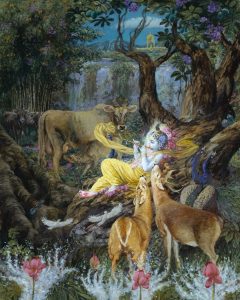 rāgātmika. Sādhakas who follow the moods of these inhabitants of Vraja in order to attain their bhāva are called rāgānuga. Amongst these rāgānuga-sādhakas, only those who specifically follow the internal mood of Śrī Rūpa Mañjarī are rūpānuga. Thus, every rūpānuga-sādhaka is also a rāgānuga-sādhaka, but rāgānuga-sādhakas are not necessarily rūpānuga. Rūpānuga-sādhakas are those who with the external body follow the process of bhajana as given by Śrīla Rūpa Gosvāmī, and simultaneously with their internally conceived spiritual body (siddha-deha) follow the moods of Śrī Rūpa Mañjarī as she eternally serves Śrī Śrī Rādhā-Kṛṣṇa in Vraja. Only that sort of rāgānuga-sādhaka is a rūpānuga Vaiṣṇava. The topmost follower of Śrīla Rūpa Gosvāmī (rūpānuga-vara), Śrīla Raghunātha dāsa Gosvāmī, prays in his Śrī Vilāpa-kusumāñjali (96, 16):
rāgātmika. Sādhakas who follow the moods of these inhabitants of Vraja in order to attain their bhāva are called rāgānuga. Amongst these rāgānuga-sādhakas, only those who specifically follow the internal mood of Śrī Rūpa Mañjarī are rūpānuga. Thus, every rūpānuga-sādhaka is also a rāgānuga-sādhaka, but rāgānuga-sādhakas are not necessarily rūpānuga. Rūpānuga-sādhakas are those who with the external body follow the process of bhajana as given by Śrīla Rūpa Gosvāmī, and simultaneously with their internally conceived spiritual body (siddha-deha) follow the moods of Śrī Rūpa Mañjarī as she eternally serves Śrī Śrī Rādhā-Kṛṣṇa in Vraja. Only that sort of rāgānuga-sādhaka is a rūpānuga Vaiṣṇava. The topmost follower of Śrīla Rūpa Gosvāmī (rūpānuga-vara), Śrīla Raghunātha dāsa Gosvāmī, prays in his Śrī Vilāpa-kusumāñjali (96, 16):
tavaivāsmi tavaivāsmi
na jīvāmi tvayā vinā
iti vijñāya devī tvaṁ
naya māṁ caraṇāntike
He Devī Śrī Rādhike! I am Yours! I am Yours! I cannot live without You. Knowing this, please give me a place at Your lotus feet.
pādābjayos tava vinā vara-dāsyam eva
nānyat kadāpi samaye kila devī yāce
sākhyāya te mama namo ’stu namo ’stu nityaṁ
dāsyāya te mama raso ’stu raso ’stu satyam
O Devī Rādhike, I never beg for anything but that most exalted direct service unto Your lotus feet. Time and again I offer praṇāma from afar to the position as Your sakhī, but I vow that my unwavering devotion should always be only to be Your maidservant.
We also see Śrīla Narottama Ṭhākura’s desire to be a rūpānuga in his prayer:
śrī-rūpa-mañjarī-pada, sei mora sampada,
sei mora bhajana-pūjana
sei mora prāṇa-dhana, sei mora ābharaṇa,
sei mora jīvanera jīvana
sei mora rasa-nidhi sei mora vāñchā-siddhi,
sei mora vedera dharama
The lotus feet of Śrī Rūpa Mañjarī are my dear-most treasure. They are the topmost object of my worship and inner devotional practices. Her lotus feet are my most cherished wealth, more dear than my own life. They are the exquisite ornament of my life, and indeed they are the very essence of my existence. Her lotus feet are the treasure house of rasa. They bestow the perfection of my desires and they are the conclusion of all the Vedas.
Śrīla Bhaktivinoda Ṭhākura, an ācārya for the followers of Śrī Rūpa Gosvāmī, submits the following plea in his Gīta-mālā (Part Five – Siddhi-lālasā):
śrī-rūpa-mañjarī, saṅge yābo kabe,
rasa-sevā-śikṣā-tare
tad-anugā ha’ye, rādhā-kuṇḍa-taṭe,
rahiba harṣitāntare
When will Śrī Rūpa Mañjarī take me with her to the banks of Śrī Rādhā-kuṇḍa to teach me rasa-sevā? I will live there under her guidance and pass my time feeling great delight within my heart.
śrī-rādhāra sukhe, kṛṣṇera ye sukha,
jāniba manete āmi
rādhā-pāda chāḍi, śrī-kṛṣṇa-saṅgame,
kabhu nā haiba kāmī
rādhā-pakṣa chāḍi, je jana se jana,
je bhāve se bhāve thāke
āmi ta rādhikā, pakṣa-pātī sadā,
kabhu nāhi heri tāke
I know that Rādhikā’s pleasure is Kṛṣṇa’s only source of joy. Therefore, I will never desire to abandon Her lotus feet to enjoy separately with Him. I am always in Rādhikā’s entourage and I never even glance upon the faces of those who leave Her, no matter who they are or what their mood is.
These moods are the life and soul of the rūpānuga Vaiṣṇavas. My most revered śrīla gurupāda-padma is a prominent rūpānuga-ācārya, and his heartfelt sentiments are quite clearly manifest in this first verse of Śrī Śrī Rādhā-Vinoda-bihārī-tattvāṣṭakam. His bhāva is that Śrī Kṛṣṇa should be immersed in the remembrance of Śrī Rādhā, that He should search for Śrīmatījī, and that He should feel distressed in separation from Her. This verse expresses partiality towards Śrīmatī Rādhikā and the rūpānuga conception in both separation and union.
sevya-sevaka-sambhoge
dvayor-bhedaḥ kuto bhavet
vipralambhe tu sarvasya
bhedaḥ sadā vivardhate (2)
Śrī Kṛṣṇa is sevya (He who always takes service from the sevaka) and bhoktā (He who is always enjoying). Śrīmatī Rādhikā is sevaka (She who always serves the sevya) and bhogya (She who is enjoyed). When They meet together and enjoy each other, how can there be any distinction between Them? (At that time bheda, or distinction, vanishes and abheda, or non-difference, is apparent.) However, in the stage of vipralambha, or separation, bheda perpetually becomes more intense.
Tattva-prakāśikā-vṛtti
At the time of union (sambhoga), no difference exists between sevya, the one who is served, and sevaka, the one who serves. Śrī Nanda-nandana, who is the embodiment of śṛṅgāra-rasa, the mellow of amorous love, is the ultimate limit of sevya- or bhoktā-tattva, and Śrīmatī Rādhikā is the ultimate limit of sevaka-tattva, or āśraya-tattva. Their anurāga is known as sthāyī-bhāva, permanent emotion. When this anurāga reaches its ultimate limit it is known as yāvadāśraya-vṛtti. In that stage, Śrīmatī Rādhikā’s unprecedented anurāga for Kṛṣṇa 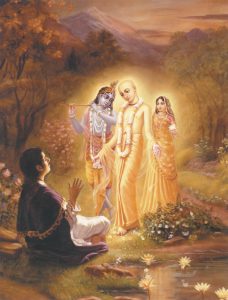 attains the level of svasamvedya-daśā, when the aṣṭa-sāttvika-bhāvas, the eight types of bodily transformations arising from śuddha-sattva, manifest in the sudīpta, or blazing, condition. [Only Śrī Rādhā, who is Śrī Kṛṣṇa’s special beloved, attains this stage.]
attains the level of svasamvedya-daśā, when the aṣṭa-sāttvika-bhāvas, the eight types of bodily transformations arising from śuddha-sattva, manifest in the sudīpta, or blazing, condition. [Only Śrī Rādhā, who is Śrī Kṛṣṇa’s special beloved, attains this stage.]
In this special condition, the sevya and sevaka both completely forget Their own identities. They also forget the distinctions, ‘He is the lover’ and ‘I am the beloved’. Their hearts melt and become one. In this stage it is not possible to conceive of or imagine any distinction between Them. However, in the stage of separation, They are both seen searching for each other in great distress. The dialogue between Rāya Rāmānanda and Śrī Caitanya Mahāprabhu on the banks of the sacred river Godāvarī gives us insight into this glorious and unprecedented rasarāja-mahābhāva, Śrīmatī Rādhikā and Śrī Kṛṣṇa’s combined form, which manifests as Śrīman Mahāprabhu.
duṅhu-mana manobhava peṣala jāni’
kānu-ṭhāme kahabi vichurala jāni’
Śrī Caitanya-caritāmṛta (Madhya-līlā 8.194)
Śrī Svarūpa Dāmodara has also envisioned this profound and confidential bhāva in his diary:
rādhā kṛṣṇa-praṇaya-vikṛtir hlādinī śaktir asmād
ekātmānāv api bhuvi purā deha-bhedaṁ gatau tau
caitanyākhyaṁ prakaṭam adhunā tad-dvayaṁ caikyam āptaṁ
rādhā-bhāva-dyuti-suvalitaṁ naumi kṛṣṇa-svarūpam
Śrī Caitanya-caritāmṛta (Ādi-līlā 1.5)
Śrīmatī Rādhikā is Kṛṣṇa’s hlādinī-śaktī, His pleasure-giving potency, and the embodiment of the transformation 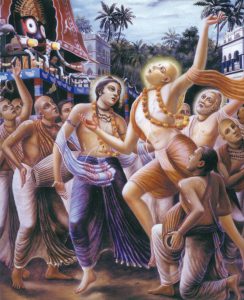 of His praṇaya, intimate love. Since They are one soul (ekātmāsvarūpa), She is intrinsically non-different from Kṛṣṇa and is one in identity with Him. However, to enjoy the transcendental pleasure of Their loving pastimes, Rādhā and Kṛṣṇa have eternally manifested Themselves in these two apparently separate forms. Now these two transcendental identities, sevya and sevaka, viṣaya-tattva and āśraya-tattva, have manifested in one form as śrī caitanya-tattva. I repeatedly bow down to Śacīnandana, who is the svarūpa of Kṛṣṇa and who is adorned with the moods and complexion of Śrīmatī Rādhikā.
of His praṇaya, intimate love. Since They are one soul (ekātmāsvarūpa), She is intrinsically non-different from Kṛṣṇa and is one in identity with Him. However, to enjoy the transcendental pleasure of Their loving pastimes, Rādhā and Kṛṣṇa have eternally manifested Themselves in these two apparently separate forms. Now these two transcendental identities, sevya and sevaka, viṣaya-tattva and āśraya-tattva, have manifested in one form as śrī caitanya-tattva. I repeatedly bow down to Śacīnandana, who is the svarūpa of Kṛṣṇa and who is adorned with the moods and complexion of Śrīmatī Rādhikā.
In this verse, Śrī Svarūpa Dāmodara has used the word ekātmā to establish that Śrī Śrī Rādhā-Kṛṣṇa, sevaka-tattva and sevya-tattva, are nondifferent from each other. Then he says, ‘deha bhedaṁ gatau tau’ to indicate the difference between the two tattvas. Param-rasika tattvaācārya Śrīla Gurupāda-padma has indicated these same profound and confidential sentiments in the second verse of his composition.
cil-līlā-mithunaṁ tattvaṁ
bhedābhedam acintyakam
śakti-śaktimator aikyaṁ
yugapad vartate sadā (3)
The eternal Divine Couple are the embodiments of the combined form of śakti and śaktimān. To fulfil Their transcendental, pleasure-giving pastimes, They join and become one in the stage of union (sambhoga) and yet simultaneously and inconceivably exist as different and non-different from each other. This means that para-tattva is never without potency (niḥśaktik). Śakti and śaktimān are eternally united together in that para-tattva. He is puruṣottama, the Supreme Male, endowed with completely transcendental pastimes, the original Self in the amorous form, the combined form of śakti and śaktimān. That amorous form is Śrī Śrī Rādhā-Kṛṣṇa as gaura-tattva. By the influence of acintya-śakti, the contrary principles of difference and non-difference simultaneously reside in Him eternally.
Tattva-prakāśikā-vṛtti
Śrī Vrajendra-nandana Śrī Kṛṣṇa is the non-dual Absolute Truth (advaya-jñāna para-tattva). He is the embodiment of the nectar of all mellows (akhila-rasāmṛta-mūrti ), and He possesses all potencies (sarva-śaktimān). His natural internal potency is also one and is known as svarūpa-śakti. By the desire of śaktimān Śrī Kṛṣṇa, this singular potency manifests in various forms to accomplish different tasks. It expands itself in the form of citśakti to manifest the spiritual world (cit-jagat), as jīva-śakti to manifest all the living entities, and as māyā-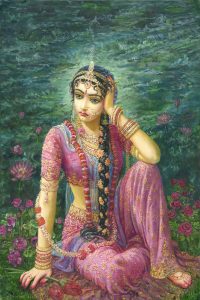 śakti to manifest the entire material creation. This potency also fulfils Śrī Kṛṣṇa’s various desires in the form of saṁvit, sandhinī and hlādinī. Prema is the essence of hlādinī, mahābhāva is the essence of prema, and Śrīmatī Rādhikā is the embodiment of this mahābhāva. That parā-śakti, which is the essence of the essence of prema in the form of Śrīmatī Rādhikā, eternally fulfils all the desires of Śrī Kṛṣṇa, who is the personification of śṛṅgāra-rasa. At the time of union, Rādhā-Kṛṣṇa are mithuna-tattva, or yugala-tattva, the amorous Couple. That is to say, Śrī Kṛṣṇa, desiring to relish a particular type of rasa, has accepted the external bodily lustre and the internal mahābhāva of Śrīmatī Rādhikā, and is eternally present in the form of Śrī Gaurasundara, who is Rādhā-Kṛṣṇa combined. Thus Śrī Gaurasundara is also mithuna-tattva. Svayam Bhagavān Śrī Caitanya Mahāprabhu and His Gauḍīya Vaiṣṇava ācāryas have accepted Śrī Śrī Rādhā-Kṛṣṇa’s simultaneous and inconceivable difference and non-difference. This truth has been established in the first verse.
śakti to manifest the entire material creation. This potency also fulfils Śrī Kṛṣṇa’s various desires in the form of saṁvit, sandhinī and hlādinī. Prema is the essence of hlādinī, mahābhāva is the essence of prema, and Śrīmatī Rādhikā is the embodiment of this mahābhāva. That parā-śakti, which is the essence of the essence of prema in the form of Śrīmatī Rādhikā, eternally fulfils all the desires of Śrī Kṛṣṇa, who is the personification of śṛṅgāra-rasa. At the time of union, Rādhā-Kṛṣṇa are mithuna-tattva, or yugala-tattva, the amorous Couple. That is to say, Śrī Kṛṣṇa, desiring to relish a particular type of rasa, has accepted the external bodily lustre and the internal mahābhāva of Śrīmatī Rādhikā, and is eternally present in the form of Śrī Gaurasundara, who is Rādhā-Kṛṣṇa combined. Thus Śrī Gaurasundara is also mithuna-tattva. Svayam Bhagavān Śrī Caitanya Mahāprabhu and His Gauḍīya Vaiṣṇava ācāryas have accepted Śrī Śrī Rādhā-Kṛṣṇa’s simultaneous and inconceivable difference and non-difference. This truth has been established in the first verse.
Śrī Śaṅkara Ācārya accepted the unqualified, formless and powerless brahma as para-tattva. This brahma is without differences within itself (svagata-bheda), differences from others of the same kind or category (sajātīya-bheda) and differences from others of different kinds or categories (vijātīya-bheda). He called this doctrine kevalādvaita-vāda. Many ācāryas have used irrefutable logic and strong śāstric evidence to cut Śrī Śaṅkara’s doctrine of nirviśeṣa kevalādvaita. These ācāryas include Śrī Kṛṣṇa Dvaipāyana Vedavyāsa, the author of Vedānta-sūtra ; Parāśara; Auḍulaumi and other ācāryas of ancient times who had realized knowledge of the Absolute Truth; Vaiṣṇava ācāryas such as Śrī Rāmānuja, Śrī Madhva, Śrī Viṣṇusvāmī and Śrī Nimbāditya; Śaivite ācāryas such as Śrī Nīlakaṇṭha; as well as ācāryas such as Śrī Bhāskara Ācārya who came in a later period.
Vaiṣṇava ācāryas have accepted para-brahma and His śakti, as well as the extremely beautiful sac-cid-ānanda śrī vigraha of para-brahma who possesses all attributes (saviśeṣa). Ācāryas from the different Vaiṣṇava sampradāyas have propagated pure bhakti in the world: Śrī Rāmānuja preached viśiṣṭādvaita-vāda, Śrī Madhvācārya presented dvaita-vāda, Śrī Viṣṇusvāmī śuddhādvaita-vāda and Śrī Nimbāditya svābhāvika dvaitādvaita- (bhedābheda-) vāda. According to Śrī Rāmānuja, para-tattva is the saviśeṣa–brahma who possesses both cit and acit śaktis. According to Śrī Madhvācārya, there are five types of eternal differences: between (1) brahma and jīva, (2) jīva and jīva, (3) jīva and jaḍa (inert matter), (4) jaḍa and jaḍa and (5) jaḍa and brahma. Śrī Viṣṇusvāmī has accepted that the eternal vigraha of para-brahma, His associates, His pastimes, His abode and so on all exist in the plane of pure existence beyond the jurisdiction of māyā. Similarly, Śrī Nimbāditya has accepted the natural difference and non-difference between saviśeṣa–brahma, jīva and jagat.
Svayam Bhagavān Śrī Caitanya Mahāprabhu has completed the opinions of the Vaiṣṇava ācāryas wherever they were lacking. He has embraced the universal doctrines of the Vedas and the Upaniṣads, and has established the relationship of eternal oneness and difference between para-brahma, śakti, and also jīva and jagat, which are transformations of śakti. This difference (bheda) and oneness (abheda) is acintya, inconceivable, because it is beyond the conception of human intelligence and can be understood only by following scriptural wisdom. The Vaiṣṇava ācāryas following in the footsteps of Śrīman Mahāprabhu have accepted this acintya-bhedābheda-tattva.
No scriptures have ever referred to para-tattva as being without distinctions, without potency, formless or devoid of transcendental qualities. In Śrīla Vedavyāsa’s Brahma-sūtra we find sūtras such as janmādy asya yataḥ, arūpavadeva tat-pradhānatvāt, api saṁrādhane pratyakṣānumānābhyām and ānandamayo ’bhyāsāt, and in Vedānta also śakti-śaktimator abhedaḥ. Thus, Śrīla Vyāsadeva has openly accepted the sac-cid-ānanda vigraha, śakti, name, form, qualities, pastimes and abode of para-brahma, the Supreme Entity. Various mantras in the Upaniṣads also firmly establish the śakti of para-brahma, His sac-cid-ānanda vigraha and the doctrine of bheda and abheda, and other transcendental conclusions. For example, we read: yato vā imāni bhutāni jāyante, yena jātāni jīvanti, yat prayanty abhisaṁviśanti tad vijijñāsasva tad brahma ; nityo nityānāṁ cetanaś cetanānām and parāsya śaktir vividhaiva śrūyate.
We find descriptions of the transcendental nature, name, form, qualities, pastimes and associates of para-brahma, as well as acintya-bhedābheda-tattva, throughout Śrīmad-Bhāgavatam, the crown jewel of all authentic evidence. All these conclusions have been specifically supported by verses such as aho bhāgyam aho bhāgyaṁ nanda-gopa-vrajaukasām / yan-mitraṁ paramānandaṁ pūrṇaṁ brahma sanātanam ; gūḍhaṁ paraṁ brahma manuṣyaliṅgam and kṛṣṇas tu bhagavān svayam. All these doctrines are specifically and distinctly described in the catuḥ-ślokī of Śrīmad-Bhāgavatam (2.9.33–36). We will not give an elaborate description here for want of sufficient space.
tattvam ekaṁ paraṁ vidyāl-
līlayā tad dvidhā-sthitam
gauraḥ kṛṣṇaḥ svayaṁ hy etad
ubhāv ubhayam āpnutaḥ (4)
The non-dual Absolute Truth, advayajñāna para-tattva, is one. But, that Absolute Truth is eternally manifested in two forms for the sake of conducting pastimes. One form is that of Śrī Gaurasundara and the other is that of Śrī Kṛṣṇasundara. Both are para-tattva and are non-different from each other. Truly, Śrī Gaurasundara is Kṛṣṇa Himself and Śrī Kṛṣṇasundara is Śrī Gaurasundara. Both manifest both forms; that is to say, Śrī Kṛṣṇasundara has become Śrī Gaurasundara and Śrī Gaurasundara has become Śrī Kṛṣṇasundara.
Tattva-prakāśikā-vṛtti
Śrī Svarūpa Dāmodara, who is the main internal associate of Śrī Gaurasundara, has elaborately explained the confidential siddhānta of śrī gaura-kṛṣṇa-tattva in his diary:
rādhā kṛṣṇa-praṇaya-vikṛtir hlādinī śaktir asmād
ekātmānāv api bhuvi purā deha-bhedaṁ gatau tau
caitanyākhyaṁ prakaṭam adhunā tad-dvayaṁ caikyam āptaṁ
rādhā-bhāva-dyuti-suvalitaṁ naumi kṛṣṇa-svarūpam
Śrī Caitanya-caritāmṛta (Ādi-līlā 1.5)
The purport is that Śrī Śrī Rādhā-Kṛṣṇa are one identity. Śrīmatī Rādhikā‚ who is the embodiment of mahābhāva, 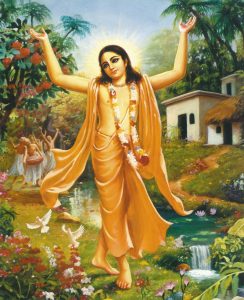 and Śrī Kṛṣṇa, who is the embodiment of all rasa, assume one form to enjoy pleasurable pastimes when they meet (sambhoga). At that time They forget even the mood of being lover and beloved, and thus it is impossible even to imagine any difference between the two. But in separation, Śrī Śrī Rādhā-Kṛṣṇa manifest two separate forms and relish vipralambhā-bhāva through various loving pastimes. Again, in order to enjoy some special bhāvas, these two tattvas unite and manifest Themselves in the form of Śrī Śacīnandana Gaurahari. Actually, Śrīmatī Rādhikā is the transformation of Kṛṣṇa’s praṇaya (intimate love), and She is also His svarūpa-śakti. She gives pleasure to Him by fulfilling all His desires, and that is why She is also called hlādinī-śakti.
and Śrī Kṛṣṇa, who is the embodiment of all rasa, assume one form to enjoy pleasurable pastimes when they meet (sambhoga). At that time They forget even the mood of being lover and beloved, and thus it is impossible even to imagine any difference between the two. But in separation, Śrī Śrī Rādhā-Kṛṣṇa manifest two separate forms and relish vipralambhā-bhāva through various loving pastimes. Again, in order to enjoy some special bhāvas, these two tattvas unite and manifest Themselves in the form of Śrī Śacīnandana Gaurahari. Actually, Śrīmatī Rādhikā is the transformation of Kṛṣṇa’s praṇaya (intimate love), and She is also His svarūpa-śakti. She gives pleasure to Him by fulfilling all His desires, and that is why She is also called hlādinī-śakti.
In Tattva-sandarbha, Śrīla Jīva Gosvāmī has quoted verses from the Saṁhitās which reveal that Śrī Gaurasundara is the combined form of Śrī Kṛṣṇa and Śrī Rādhā:
antaḥ kṛṣṇaṁ bahir gauraṁ
darśitāṅgādi-vaibhavam
kalau saṅkīrtanādyaiḥ sma
kṛṣṇa-caitanyam āśritāḥ
Tattva-sandarbha (2)
I take shelter of Śrī Kṛṣṇa Caitanya Mahāprabhu in Kali-yuga through the process of saṅkīrtana. Internally He is Śrī Kṛṣṇa Himself, and externally He appears in His gaura-svarūpa. He has manifested Himself along with His majestic influence beginning with His aṅga, or limbs, and upāṅga, or subsidiary limbs. (Namely, Śrī Nityānanda Prabhu, Śrī Advaita Ācārya, Śrī Gadādhara and His devotees headed by Śrīvāsa).
Śrīla Rūpa Gosvāmī has also offered obeisances to the most munificent Śrī Caitanya Mahāprabhu, who distributes kṛṣṇa-prema and who is non-different from Śrī Kṛṣṇa Himself: namo mahā-vadānyāya kṛṣṇa-prema-pradāya te / kṛṣṇāya kṛṣṇa-caitanya-nāmne gaura-tviṣe namaḥ. This siddhānta has been supported in the Mārkaṇḍeya Purāṇa : golokaṁ ca parityajya lokānāṁ trāṇa-kāraṇāt / kalau gaurāṅga-rūpeṇa līlā-lāvaṇya-vigrahaḥ.
In many other scriptures, and especially in the books of the Gosvāmīs, there is plenty of evidence proving that Śrī Gaurasundara is Śrī Kṛṣṇa, and vice versa. In Śrī Caitanya-caritāmṛta (Ādi-līlā 2.109) it is stated: sei kṛṣṇa avatārī vrajendra-kumāra / āpane caitanya-rūpe kaila avatāra. Śrīla Narottama Ṭhākura has also written: vrajendra-nandana jei śacī-sūta haila sei / balarāma haila nitāi.
sarve varṇāḥ yatrāviṣṭāḥ
gaura-kāntir vikāśate
sarva-varṇena hīnas tu
kṛṣṇa-varṇaḥ prakāśate (5)
When all colours are mixed together, a golden hue manifests. For instance, the sun is golden because all the colours are present in it. On the other hand, the absence of all colours yields a blackness that is beyond mundane colour.
Tattva-prakāśikā-vṛtti
Śrī Kṛṣṇa and Śrī Gaura are both the ultimate limit of para-tattva and are non-different from each other. The bodily lustre of Svayam Bhagavān Śrī Kṛṣṇa has the distinctive hue of fresh, dark-bluish rain clouds or the effulgence of a sapphire. The bodily lustre of Śrī Gaurasundara defeats the splendour of lightning and molten gold. Svayam Bhagavān Śrī Kṛṣṇa and Svayam Bhagavān Śrī Gaurasundara are both the transcendental Absolute Truth. They are completely beyond the qualities and actions of material nature, and thus They cannot be compared to anything in this mundane world. Still, some comparisons have been given, following the logic of the moon and a branch, so that conditioned souls may easily come to some understanding. However, these examples only refer to the particular aspect of the transcendental form of Bhagavān that they illustrate. They cannot be used to explain the complete form of the Absolute Truth.
At night a small child may want to see the moon, and the parent may show it to him by indicating its position  above the branch of a nearby tree. The moon appears to be just above the branch of the tree, but it is really thousands and thousands of miles away. In the same way, bhagavat-tattva is in reality completely beyond all the mundane qualities of ignorant people. Still, it is essential in the initial stage to use examples of mundane objects to describe the Absolute, so that materially conditioned people, who are completely ignorant about the transcendental truth, can at least develop some idea of Transcendence. Both the colours black and white are mundane, yet the example of these colours has been given here to convey an idea of the bodily lustre of Śrī Kṛṣṇasundara and Śrī Gaurasundara.
above the branch of a nearby tree. The moon appears to be just above the branch of the tree, but it is really thousands and thousands of miles away. In the same way, bhagavat-tattva is in reality completely beyond all the mundane qualities of ignorant people. Still, it is essential in the initial stage to use examples of mundane objects to describe the Absolute, so that materially conditioned people, who are completely ignorant about the transcendental truth, can at least develop some idea of Transcendence. Both the colours black and white are mundane, yet the example of these colours has been given here to convey an idea of the bodily lustre of Śrī Kṛṣṇasundara and Śrī Gaurasundara.
The theories of mundane scientists also support the siddhānta expressed in this verse. Scientists say that black is not a colour, so the example of the colour black points to the truth that Śrī Kṛṣṇa and His bodily lustre, which resembles the colour black, is nirguṇa, i.e., completely beyond the material qualities. Even when Śrī Kṛṣṇa advents in this material world, He and His bodily lustre are completely beyond material qualities in all respects. Moreover, all of Śrī Kṛṣṇa’s transcendental attributes are also nirguṇa, including His gravity, courtesy, His pridelessness, His respectfulness, cleverness, ever-youthfulness, His incomparable beauty, His expertise in relishing rasa, His virtues, His self-control and His extreme mercy.
Conversely, Śrī Gaurasundara’s bodily lustre and all of His qualities are transcendental. That is why He is saguṇa-tattva, the Absolute Truth possessed of all qualities. Still, His qualities are also nirguṇa. Again, following  the logic of the moon and the branch, a comparison is given here to illustrate saguṇa-tattva. Just as the sun is endowed with a combination of all colours, so Śrī Gaurasundara, who is endowed with a distinctive golden lustre, embodies all transcendental qualities. Thus, He is worshipful. When all the colours are mixed together, a golden hue manifests, in which the colours are not visible separately. For instance, the rays of the sun appear white, but sometimes in the rainy season we see a rainbow opposite the sun, and we can then see the sun’s component seven colours separately. In English the acronym ROYGBIV is used to denote the following seven colours: R – red, O – orange, Y – yellow, G – green, B – blue, I – indigo, V – violet. Following this same logic, Śrī Gaurasundara’s bodily lustre resembles molten gold because He embodies the combination of all transcendental qualities.
the logic of the moon and the branch, a comparison is given here to illustrate saguṇa-tattva. Just as the sun is endowed with a combination of all colours, so Śrī Gaurasundara, who is endowed with a distinctive golden lustre, embodies all transcendental qualities. Thus, He is worshipful. When all the colours are mixed together, a golden hue manifests, in which the colours are not visible separately. For instance, the rays of the sun appear white, but sometimes in the rainy season we see a rainbow opposite the sun, and we can then see the sun’s component seven colours separately. In English the acronym ROYGBIV is used to denote the following seven colours: R – red, O – orange, Y – yellow, G – green, B – blue, I – indigo, V – violet. Following this same logic, Śrī Gaurasundara’s bodily lustre resembles molten gold because He embodies the combination of all transcendental qualities.
One day, when our most worshipful Śrīla Gurudeva was telling us hari-kathā, he related an incident that occurred when he went to Prayāga (Allahābāda) after Śrīla Prabhupāda’s disappearance. He stayed there for a few days at the house of his dear friend and godbrother Śrī Abhaya Caraṇāravinda Prabhu, who introduced him to a well-known High Court advocate. This advocate was sharp-witted and a good logician, and he was deeply impressed on hearing the thoughts of Śrī Kṛtiratna Prabhu, who was a profound scholar of philosophy and an instructor of instructors. One day the advocate arrived at the house with a church bishop, who was a famous philosopher and preacher of Christianity. The advocate introduced the bishop to Kṛtiratna Prabhu, and for entertainment, he initiated a dialogue with him that led to an interesting argument using logic and counter-logic. During the discussion, the bishop turned to Kṛtiratna Prabhu and asked, “Why do you worship Kṛṣṇa who is coloured black?”
Showing his presence of mind, Śrīla Gurudeva immediately answered, “Black is not a colour. It is beyond all colours, which means that Kṛṣṇa is beyond all mundane qualities. We do not worship any worldly object or colour. Nirguṇa-tattva is not subject to the stages of birth, growth, decay and destruction. It is beyond the modes of goodness, passion and ignorance, and it is eternally existing. We worship Śrī Kṛṣṇa, who is the ultimate limit of nirguṇa-para-tattva.”
The bishop was an expert and sportive opponent, and immediately retorted, “Then why do you worship the fair-complexioned Śrī Gaurāṅga Mahāprabhu?”
Śrīla Gurudeva answered so quickly that it seemed that he was waiting for the question. “All the qualities of the 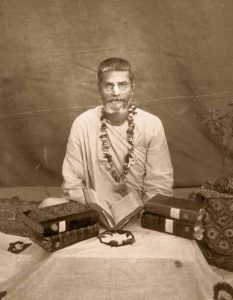 material nature are abominable and distressful. Beyond this, in the spiritual world, there is a treasure of transcendental virtuous qualities. Śrī Caitanya Mahāprabhu is the unlimited treasure house of all those transcendental qualities, and the mixture of those spiritual qualities is His bodily lustre. The combination of all the colours in sunlight appears white, but in fact it is a mixture of seven colours: red, orange, yellow, green, blue, indigo and violet. We see this in the rainy season, when the sun’s light is refracted to make a rainbow, in which all seven colours are easily visible. Similarly, our worshipful Śrī Gaurasundara embodies unlimited transcendental qualities.”
material nature are abominable and distressful. Beyond this, in the spiritual world, there is a treasure of transcendental virtuous qualities. Śrī Caitanya Mahāprabhu is the unlimited treasure house of all those transcendental qualities, and the mixture of those spiritual qualities is His bodily lustre. The combination of all the colours in sunlight appears white, but in fact it is a mixture of seven colours: red, orange, yellow, green, blue, indigo and violet. We see this in the rainy season, when the sun’s light is refracted to make a rainbow, in which all seven colours are easily visible. Similarly, our worshipful Śrī Gaurasundara embodies unlimited transcendental qualities.”
When the honourable bishop heard this irrefutable, scientific argument, he was struck dumb and became a little morose. Trying to conceal his discomfiture, he smiled and said, “You people worship a cowherd boy. I cannot understand this.”
Śrīla Gurudeva replied, “Perhaps you do not understand because you worship a shepherd. If a shepherd can be worshipped, then why is it strange to worship the caretaker of cows, who nourish the whole world like mothers?”
On hearing this, both the advocate and the bishop extolled Śrī Kṛtiratna Prabhu’s eloquent speech and took their leave.
Thus, the transcendental saguṇa and nirguṇa are an identical tattva. There is no difference between the two. There is no doubt at all that Śrī Kṛṣṇa and Śrī Gaurasundara are simultaneously saguṇa- and nirguṇa-tattva.
saguṇaṁ nirguṇaṁ tattvam
ekam evādvitīyakam
sarva-nitya-guṇair gauraḥ
kṛṣṇa rasas tu nirguṇaiḥ (6)
Constitutionally, both the saguṇa- and nirguṇa-tattvas are non-different from each other and are one without a second. Śrī Gaurasundara is saguṇa-tattva, the embodiment of unlimited, eternal, transcendental qualities. The omnipotent Śrī Kṛṣṇa, who is devoid of and beyond every mundane mode, and who is the embodiment of all rasas, is nirguṇa-tattva. Śrī Kṛṣṇa is described everywhere in the scriptures as rasa-svarūpa, the very embodiment of rasa, and rasika-śekhara, the foremost relisher of rasa. Rasa is nirguṇa-tattva, or transcendental. It can never come under the influence of the mundane modes.
Tattva-prakāśikā-vṛtti
Śrī Kṛṣṇa and Śrī Gaura are one and the same worshipful Truth. This has been concluded here by comparing the word varṇa from the previous verse with the word guṇa in this verse. Intrinsically, nirguṇa Śrī Kṛṣṇa and saguṇa Śrī Gaurasundara are the equally worshipful para-tattva and cannot be distinguished from each other. They are both simultaneously saguṇa- and nirguṇa-tattva.
Some persons, ignorant of the Absolute Truth, consider saguṇa and nirguṇa to be two separate principles. They further conclude that they are completely opposite to each other; that saguṇa-tattva is under the influence of the material modes, and thus undesirable; and that nirguṇa-tattva is therefore superior to saguṇa-tattva. According to these people, nirguṇa-tattva refers to that formless brahma which is beyond the material world, which is devoid of attributes, unalloyed, without potency and formless. They say that this world is false and that the jīva is brahma. According to them, saguṇa-tattva is the stage in which nirguṇa-tattva manifests itself in the material world, endowed with a material name, a material form and material qualities. They consider Svayam Bhagavān Śrī Kṛṣṇa and Śrī Rāmacandra to be that saguṇa-tattva, whose appearance, disappearance and body are material and influenced by illusion.
The Gītā (9.11–12) and other authorized scrip tures state that this doctrine is completely offensive: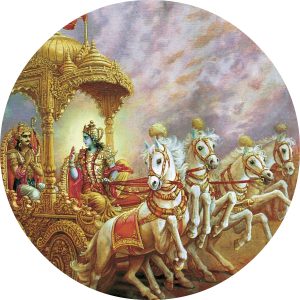
avajānanti māṁ mūḍhā
mānuṣīṁ tanum āśritam
paraṁ bhāvam ajānanto
mama bhūta-maheśvaram
moghāśā mogha-karmāṇo
mogha-jñānā vicetasaḥ
rākṣasīm āsurīṁ caiva
prakṛtiṁ mohinīṁ śritāḥ
Fools deride Me, the Supreme Lord of all living entities. They fail to understand the supreme nature of My form by their human intelligence, which is bewildered by illusion. All the hopes, actions and knowledge of such fools go in vain. Their minds become agitated and, deviating from the spiritual path, they take shelter of the demoniac nature, which destroys intelligence, and they head towards the hellish planets.
The conclusion is that Śrī Kṛṣṇa is the root of all incarnations and is the Supreme Absolute Truth. In the form of Kṛṣṇa, He is the Lord of all lords, of all living beings and of the entire cosmic manifestation. Whatever He wills must take place. He is omniscient, omnipotent and supremely compassionate. Wicked King Veṇa and other such fools used to disrespect Kṛṣṇa when they saw Him. These fools used to abuse Vasudeva-nandana, or Nanda-nandana, Śrī Kṛṣṇa, considering Him a worldly man subject to death. These fools imagine that Paramātmā is a separate soul in Kṛṣṇa’s body. This belief has been condemned everywhere in the scriptures, wherein Śrī Kṛṣṇa’s form is established as eternal and full of knowledge and bliss (saccid-ānanda). Śāstra states that the distinction between the body (deha) and the possessor of the body (dehī ) is also false in the case of the saccid-ānanda śrī vigraha of Bhagavān.
(a) sac-cid-ānanda-rūpāya kṛṣṇāya (Gopālatāpani Upaniṣad1)
(b) tam ekaṁ govindaṁ sac-cid-ānanda-vigraham (Gopāla-tāpani Upaniṣad33)
(c) dvi-bhujaṁ jñāna-mudrāḍhyaṁ vana-mālinam īśvaram (Gopāla-tāpani Upaniṣad9)
(d) īśvaraḥ paramaḥ kṛṣṇaḥ sac-cid-ānanda-vigrahaḥ (Brahmā-saṁhita1)
(e apaśyaṁ gopām anipadyamānamā (Ṛg Veda22.164.31)
(f) gūḍhaṁ paraṁ brahma manuṣya-liṅgam (Śrīmad-Bhāgavatam 7.10.48)
(g) yatrāvatīrṇo bhagavān paramātmā narākṛtiḥ (Śrīmad-Bhāgavatam23.20)
(h) deha-dehi-bhidā nāsti īśvare vidyate kvacid
Bhagavān Śrī Kṛṣṇa is unborn, yet by dint of His inconceivable potency, He is the eternal son of Śrī Nanda and Śrī Yaśodā. He is nirguṇa, yet He is ever youthful, the best of dancers, and He is dressed as a cowherd boy carrying a flute. He is equally disposed to all, and yet He is partial to His devotees who take exclusive shelter of Him. According to viruddha dharmaṁ tasmin na citram, all apparently contradictory and mutually exclusive qualities co-exist simultaneously within Bhagavān. Four-headed Brahmā and other demigods have referred to Him as being simultaneously saguṇa and nirguṇa.
Rāvaṇa thought that Śrī Rāmacandra was an ordinary human being, so he kidnapped Sītā-devī, His svarūpa-śakti, His internal potency. Śrī Rāmacandra later killed Rāvaṇa as well as all his demon followers and rescued Sītā-devī. Kaṁsa, Jarāsandha, Śiśupāla and other foolish kings thought that Bhagavān Śrī Kṛṣṇa was an ordinary human being. By His causeless mercy, Śrī Kṛṣṇa destroyed them, either personally with His disk Sudarśana or through His devotees, and established His divine position as nirguṇa, or above material qualities. Svayam Bhagavān Śrī Kṛṣṇa has said in the Gītā (10.10), “dadāmi buddhi-yogaṁ taṁ yena mām upayānti te – I give them the intelligence, the divine vision, by which they can come to Me.” One cannot realize the Absolute Truth without the mercy of Bhagavān or His devotees. Hence, Śrī Kṛṣṇacandra and Śrī Gaurasundara are both equally worshipful as one and the same unparalleled and supreme tattva.
śrī-kṛṣṇaṁ mithunaṁ brahma
tyaktvā tu nirguṇaṁ hi tat
upāsate mṛṣā vijñāḥ
yathā tuṣāvaghātinaḥ (7)
Śrī Kṛṣṇa and Śrī Gaura are both the same supreme brahma. Those who abandon Their service to worship the formless brahma never attain factual liberation, and are precisely like those who try to extract rice by beating empty husks. All they obtain is their own fruitless, hard labour. Similarly, all seekers of empirical knowledge, who forsake the service of Śrī Kṛṣṇa to worship the nirviśeṣa nirguṇa brahma, simply perform fruitless hard labour. All their efforts go in vain.
Tattva-prakāśikā-vṛtti
The Vedas, Upaniṣads and especially Vedānta-sūtra describe only bhakti. The topic established by all these scriptures is Bhagavān and His bhakti. The word jñāna has not been mentioned even once in the five hundred and fifty aphorisms of Vedānta-sūtra. The sūtra ‘janmādy asya yataḥ’ (1.1.2) clearly states that Bhagavān is the creator, maintainer and destroyer of this cosmic manifestation. This proves the divine existence of His form, energies and transcendental qualities. The sūtra ‘arūpavadeva tat-pradhānatvāt’ (3.2.14) describes the transcendental form of para-brahma. The sūtra ‘ānandamayo ’bhyāsāt’ (1.1.12) confirms para-brahma’s pleasurable pastimes and ‘anāvṛttiḥ śabdād anāvṛttiḥ śabdāt’ (4.4.22) states that the only process to attain the Supreme Truth is nāma-saṅkīrtana. In the prayers of Śrī Brahmā in Śrīmad-Bhāgavatam (10.14.4), the cultivation of nirviśeṣa-jñāna has been forbidden:
śreyaḥ-sṛtiṁ bhaktim udasya te vibho
kliśyanti ye kevala-bodha-labdhaye
teṣām asau kleśala eva śiṣyate
nānyad yathā sthūla-tuṣāvaghātinām
O Prabhu, You are the ultimate auspiciousness‚ and bhakti is the best and only means to obtain You. The four types of desirable goals such as mokṣa are easily attained by performing bhakti, just as water continuously flows from a reservoir. When one performs bhakti, one is automatically situated in knowledge, so one need not endeavour to obtain jñāna separately. Those who abandon the path of bhakti and engage in distressing endeavours to achieve jñāna reap only suffering and nothing else, just as those who beat empty husks receive no reward but their own fruitless hard labour. They do not obtain any rice. Furthermore in Śrīmad-Bhāgavatam (10.2.32):
ye ’nye ’ravindākṣa vimukta-māninas
tvayy asta-bhāvād aviśuddha-buddhayaḥ
āruhya kṛcchreṇa paraṁ padaṁ tataḥ
patanty adho ’nādṛta-yuṣmad-aṅghrayaḥ
O lotus-eyed one, those who are not Your devotees may consider themselves to be liberated by their performance of sense control and severe sādhana, but their intelligence is not pure, because they are devoid of the sentiments of unalloyed devotion for You. As a result of neglecting Your lotus feet, which are the only shelter, they again fall down to a degraded condition.
The four Kumāras and Śrī Śukadeva previously worshipped the nirguṇa nirākāra brahma. However, by the 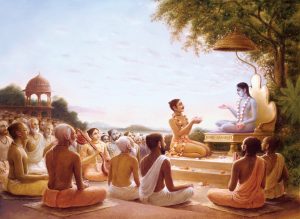 mercy of Grandsire Brahmā and Kṛṣṇa Dvaipāyana Vedavyāsa, they became attracted to the worship of the mithuna-brahma, the Divine Couple, Śrī Śrī Rādhā-Kṛṣṇa. The special qualities and sweetness of this mithuna-brahma are so attractive that even brahma-jñānīs (seekers of empiric knowledge) discard their previous condition of being ātmārāma, absorbed in the pleasure of the ātmā, and become blissfully engaged in the worship of Śrī Śrī Rādhā-Kṛṣṇa mithuna-tattva:
mercy of Grandsire Brahmā and Kṛṣṇa Dvaipāyana Vedavyāsa, they became attracted to the worship of the mithuna-brahma, the Divine Couple, Śrī Śrī Rādhā-Kṛṣṇa. The special qualities and sweetness of this mithuna-brahma are so attractive that even brahma-jñānīs (seekers of empiric knowledge) discard their previous condition of being ātmārāma, absorbed in the pleasure of the ātmā, and become blissfully engaged in the worship of Śrī Śrī Rādhā-Kṛṣṇa mithuna-tattva:
ātmārāmāś ca munayo
nirgranthā apy urukrame
kurvanty ahaitukīṁ bhaktim
ittham-bhūta-guṇo hariḥ
Śrīmad-Bhāgavatam (1.7.10)
Liberated sages freed from all material attachments and absorbed in self-realization are attracted to the Supreme Lord Hari’s transcendental qualities and desire to serve Him with pure devotion.
pariniṣṭhito ’pi nairguṇya
uttama-śloka-līlayā
gṛhīta-cetā rājarṣe
ākhyānaṁ yad adhītavān
Śrīmad-Bhāgavatam (2.1.9)
Śrīla Śukadeva Gosvāmī personally testified in Śrīmad-Bhāgavatam, “I myself was firmly situated in the worship of nirguṇa–brahma, but by the mercy of Śrīla Vyāsadeva, I was inspired to engage in the nectarean worship of the Divine Couple, Śrī Śrī Rādhā-Kṛṣṇa.”
The result of worshipping nirguṇa-brahma is liberation (mukti ). A one-pointed devotee never accepts such mukti, even if it is offered by Bhagavān. He desires to be engaged in the loving devotional service of Bhagavān forever. Great brahma-jñānīs occasionally attain mukti by their hard austerities and severe sādhana, yet that same mukti is attained very easily by outright demons when they are killed by Bhagavān Himself. So who but a fool would vainly endeavour to achieve such a condemned and low class of liberation? Wise devotees never accept such undesirable mukti even if Bhagavān Himself offers it to them.
śrī-vinoda-bihārī yo
rādhayāḥ milito yadā
tadāhaṁ vandanaṁ kuryāṁ
sarasvatī-prasādataḥ (8)
By the causeless grace of my gurudeva, Śrīla Sarasvatī Prabhupāda, I worship Śrī Vinoda-bihārī Śrī Kṛṣṇa, when, upon meeting with Śrīmatī Rādhikā, He becomes one with Her.
Tattva-prakāśikā-vṛtti
This verse reveals yet another of its author’s confidential moods. The purport of ‘when Śrī Vinoda-bihārī is meeting with Śrīmatī Rādhikā’ has been thoroughly explained in the first verse. When Kṛṣṇa is deeply absorbed in remembering Śrīmatī Rādhikā, His effulgence takes on a golden hue. Alternatively, the poet is bowing down again and again to rādhāliṅgita Śrī Vinoda-bihārī, the form of Śrī Kṛṣṇa whose bluish effulgence has been covered by the golden lustre of Śrīmatī Rādhikā when She embraces Him in union after separation. The 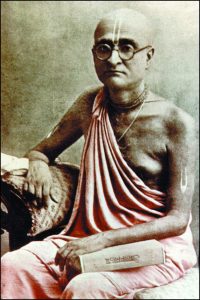 underlying meaning is to pray exclusively to mithuna-brahma Śrī Śrī Rādhā-Vinoda-bihārī, the divine form of rasarāja-mahābhāva. Sarasvatī-prasādataḥ means ‘by the causeless mercy of my gurudeva’. The name of his gurudeva is Śrī Bhaktisiddhānta Sarasvatī. The word ‘Sarasvatī’ has two meanings: (1) the presiding deity of aparā-vidyā, worldly knowledge, and (2) the presiding deity of parā-vidyā, transcendental knowledge. Śrī Sarasvatī Ṭhākura is non-different from the presiding deity of parā-vidyā. Thus, without his mercy it is impossible to worship śrī rādhāliṅgita-vigraha.
underlying meaning is to pray exclusively to mithuna-brahma Śrī Śrī Rādhā-Vinoda-bihārī, the divine form of rasarāja-mahābhāva. Sarasvatī-prasādataḥ means ‘by the causeless mercy of my gurudeva’. The name of his gurudeva is Śrī Bhaktisiddhānta Sarasvatī. The word ‘Sarasvatī’ has two meanings: (1) the presiding deity of aparā-vidyā, worldly knowledge, and (2) the presiding deity of parā-vidyā, transcendental knowledge. Śrī Sarasvatī Ṭhākura is non-different from the presiding deity of parā-vidyā. Thus, without his mercy it is impossible to worship śrī rādhāliṅgita-vigraha.
Another confidential meaning is ‘tadā ahaṁ śrī-vinoda-bihārī vandanaṁ kuryāt – I worship the divine form of Śrī Vinoda-bihārī-rādhāliṅgita’. The name Śrī Vinoda-bihārī has been given to the poet by his gurudeva. In addition to this, the name of his eternal spiritual form is Śrī Vinoda Mañjarī. This is evident from his praṇāma-mantra : gaurāśraya-vigrahāya kṛṣṇa-kāmaika-cāriṇe / rūpānuga-pravarāya vinodeti svarūpiṇe. Thus, in this prayer the poet aspires to be eternally engaged in his perfected spiritual body in the permanent service to that Śrī Kṛṣṇa who is embraced by Śrīmatī Rādhikā. The realization of such a rarely fulfilled aspiration is impossible without the mercy of śrī gurudeva, the condensed embodiment of mercy and compassion: śrī-guru-caraṇe rati, ei se uttamāgati / je prasāde pūre sarva āśā.
iti tattvāṣṭakaṁ nityaṁ
yaḥ paṭhet śraddhayānvitaḥ
kṛṣṇa-tattvam abhijñāya
gaura-pade bhaven matiḥ (9)
Whoever daily recites this tattvāṣṭakam with great faith will fully comprehend śrī kṛṣṇatattva, and will develop divine love for the lotus feet of Śrī Gaurasundara.
*Editor: ‘The logic of the branch and the moon’: even though the moon is far away in the heavens, one may indicate its whereabouts with reference to something close at hand, for example, the branch of a tree.
Source: Purebhakti.com
Image/Art made possible by Pixabay.com, Krishnapath.org and/or Bhaktiart.net

